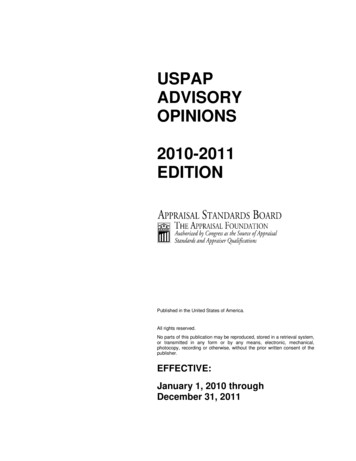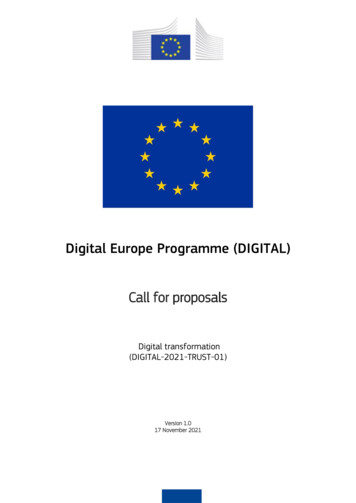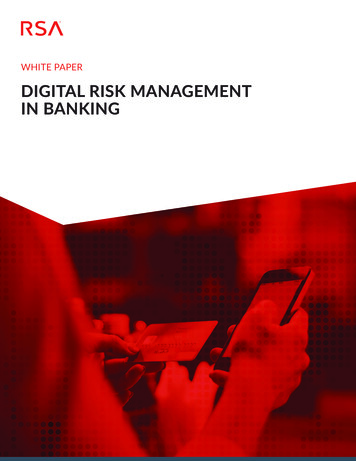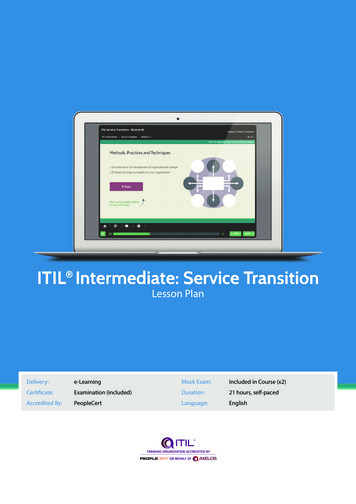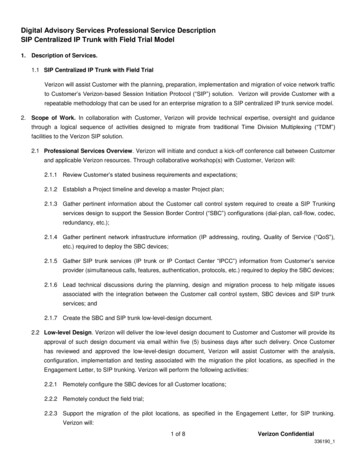
Transcription
Digital Advisory Services Professional Service DescriptionSIP Centralized IP Trunk with Field Trial Model1. Description of Services.1.1 SIP Centralized IP Trunk with Field TrialVerizon will assist Customer with the planning, preparation, implementation and migration of voice network trafficto Customer’s Verizon-based Session Initiation Protocol (“SIP”) solution. Verizon will provide Customer with arepeatable methodology that can be used for an enterprise migration to a SIP centralized IP trunk service model.2. Scope of Work. In collaboration with Customer, Verizon will provide technical expertise, oversight and guidancethrough a logical sequence of activities designed to migrate from traditional Time Division Multiplexing (“TDM”)facilities to the Verizon SIP solution.2.1 Professional Services Overview. Verizon will initiate and conduct a kick-off conference call between Customerand applicable Verizon resources. Through collaborative workshop(s) with Customer, Verizon will:2.1.1 Review Customer’s stated business requirements and expectations;2.1.2 Establish a Project timeline and develop a master Project plan;2.1.3 Gather pertinent information about the Customer call control system required to create a SIP Trunkingservices design to support the Session Border Control (“SBC”) configurations (dial-plan, call-flow, codec,redundancy, etc.);2.1.4 Gather pertinent network infrastructure information (IP addressing, routing, Quality of Service (“QoS”),etc.) required to deploy the SBC devices;2.1.5 Gather SIP trunk services (IP trunk or IP Contact Center “IPCC”) information from Customer’s serviceprovider (simultaneous calls, features, authentication, protocols, etc.) required to deploy the SBC devices;2.1.6 Lead technical discussions during the planning, design and migration process to help mitigate issuesassociated with the integration between the Customer call control system, SBC devices and SIP trunkservices; and2.1.7 Create the SBC and SIP trunk low-level-design document.2.2 Low-level Design. Verizon will deliver the low-level design document to Customer and Customer will provide itsapproval of such design document via email within five (5) business days after such delivery. Once Customerhas reviewed and approved the low-level-design document, Verizon will assist Customer with the analysis,configuration, implementation and testing associated with the migration the pilot locations, as specified in theEngagement Letter, to SIP trunking. Verizon will perform the following activities:2.2.1 Remotely configure the SBC devices for all Customer locations;2.2.2 Remotely conduct the field trial;2.2.3 Support the migration of the pilot locations, as specified in the Engagement Letter, for SIP trunking.Verizon will:1 of 8Verizon Confidential336190 1
2.2.3.1Perform SIP traces within the SBC devices as deemed necessary by Verizon to validateinteroperability;2.2.3.2Provide commercially reasonable efforts to assist Customer with troubleshooting anyinteroperability issues encountered on the first business day following completion of theProfessional Services under this SOW; and2.2.3.3Perform tests to confirm that expected SIP trunk features (within the scope of this SOW) areworking properly.2.2.4 Document the test results.Verizon will perform the following tasks (based on multiple sites in a centralized call processing model):2.2.5 Consultation related to SIP design, implementation, configuration and testing of SIP trunk servicesdeploying up to the number of ACME Packet, Cisco CUBE or Sonus Session Border Controllers, asspecified in the Engagement Letter;2.2.6 Integration of the SBC device(s) with IP trunk services and single Customer call control system;2.2.7 Migrate voice and FAX traffic to SIP trunks;2.2.8 Provide consultation on SBC integration with the Customer call control system (i.e., IPPBX) supportingthe Customer locations specified in the Engagement Letter;2.2.9 Provide support for the testing and porting of Direct Inward Dial (“DID”) numbers for the pilot sitesspecified in the Engagement Letter;2.2.10 Gather dial-plan design requirements to plan and configure the SBCs;2.2.11 Verify Off-net and On-net call routing of traffic over distributed SIP trunks;2.2.12 Provide consultation on SBC integration with a single Customer call control system (i.e., IPPBX); and2.2.13 Customer is responsible for configuring its IPPBX call control system.2.3 SIP Architecture and Design. Verizon will coordinate and lead technical discussions with Customer about theSIP integration and migration. The discussions will cover the following topics:2.3.1 Verizon IP trunk functionalities and integration, such as Alternate Route Recovery Service (“ARRS”),UANI, and failover;2.3.2 The SBC features included in the Project scope:2.3.2.1Customer call control system integration with Verizon SIP trunks (IP trunk and IP ContactCenter);2.3.2.2SBC network design and connectivity (IP addressing, Local Area Network (“LAN”) connectivity,and IP routing);2.3.2.3Call-flow, codec, redundancy, and failover requirements; and2 of 8Verizon Confidential336190 1
2.3.2.4Dial-plan design and digit manipulation requirements to integrate between IPPBX, SBC, andcarrier SIP trunks.2.4 TDM to SIP Migration Planning. Verizon will facilitate technical discussions with Customer related to themigration plan. The discussions will cover the following topics:2.4.1 Verizon will work with the Customer to determine an approach to the migration, based on Customerprovided location information and numbers to be ported (DID or Toll Free Numbers “TFN”);2.4.2 Verizon will assist Customer to identify devices, circuits, and SIP trunks to be migrated; and2.4.3 Verizon will assist Customer with development of migration strategy.2.5 Quality of Service.2.5.1 Verizon will configure QoS marking in the SBC, if requested by Customer; and2.5.2 End-to-end, LAN, or Wide Area Network (“WAN”) QoS design and configuration is outside the scope ofthis SOW.2.6 Device Implementation and Integration. Verizon will perform the following tasks:2.6.1 Implement and configure SBC devices based on design engineer design documents;2.6.2 Provide SBC configuration for “inside”, “outside”, and management network connections;2.6.3 Provide SBC configuration to integrate to SIP trunk services (IP trunk or IP contact center);2.6.4 Provide SBC configuration to integrate to the Customer call control system;2.6.5 Configure SBC for basic call routing related to all SIP trunk locations;2.6.6 Test basic calls through the Verizon SIP trunk call path;2.6.7 Provide failover testing for SBC integration with the Customer call control system; and2.6.8 Configure SIP trunking on the SBC device at the Customer premise to integrate with the Customer callcontrol system and SIP trunk services.The SBC device implementation will be conducted at a day/time agreed to by both parties.2.7 Testing and Validation. Verizon will assist Customer to define a comprehensive set of test cases designed tovalidate the solution design and will lead Customer through the test cases. Customer will perform various testsusing such test cases. Customer will require access to at least two IP endpoints during the testing. Verizon willdocument the test results performed during the testing.Verizon will perform the following tasks:2.7.1 Assist Customer with the execution of the test cases, but Customer will perform the tests;2.7.2 Document test case results;3 of 8Verizon Confidential336190 1
2.7.3 Work remotely with Customer during the testing to monitor the SIP traffic within the Verizon network andanswer questions that may arise during testing; and2.7.4 In the event any issues arise during testing, Verizon will use commercially reasonable efforts to provideguidance to Customer regarding how to correct the issues.Verizon will communicate to Customer any mitigation and interoperability issues encountered with the Customercall control system after completion of the Professional Services along with re-testing requirements.2.8 SIP Trunking with IP PBX. As part of this service, Verizon will participate in technical meetings with Customer todiscuss how to integrate the Verizon SIP trunk services (IP trunk or IPCC) and SBC device(s) with the Customercall control system(s). These discussions should provide information to enable the Customer to configure its callcontrol system to integrate with the SIP trunk services. These discussions will focus on: SIP header, early offer,delay offer, CODEC design, call forward design, call transfer, transcoder resources, Dual Tone MultipleFrequency (“DTMF”) issues, digit manipulation, calling-ID information, 911 integration and call control systemredundancy/failover when integrating with Verizon SIP trunk services.2.9 Engagement Management. Verizon will designate an “Engagement Project Manager” who will act as the singlepoint of contact throughout the Engagement. The Engagement Project Manager is also responsible for managingthe change control process. Should the Engagement’s requirements change during the course of theEngagement, the Engagement Project Manager will ensure that any modifications to the SIP Centralized IPTrunk with Field Trial are agreed to and documented in writing.Customer will appoint a single point of contact that is responsible to: coordinate the Engagement activities,interact with Verizon, and ensure timely data flow and exchange of information required for execution of theEngagement within the agreed time frame.Verizon will work with Customer to schedule a kick-off discussion to initiate the Engagement. Verizon andCustomer will collaborate to determine required stakeholders and other attendees, agenda, and meeting location(i.e. on site or virtual). At or before the kick-off discussion, Customer shall provide a list of appropriate contactpersonnel with contact numbers, and appropriate on-site authorization documentation (where applicable). As anoutput of the discussion, Verizon will confirm the resources, date, time, and location for the SIP Centralized IPTrunk with Field Trial with the Customer.All Engagement Management activities and duties will be delivered remotely.3. Deliverables and Documentation to be produced by Verizon (if any). Deliverables are intended for Customer andVerizon use only. Customer may disclose a Deliverable to a third party pursuant to the Agreement’s confidentialityterms. Verizon will provide:3.1 Project timeline;3.2 Master Project plan;3.3 Low-level design document; and3.4 Solution test case results.4 of 8Verizon Confidential336190 1
4. Documentation to be produced by Customer and Customer Obligations (if any). Delivery of the SIP CentralizedIP Trunk with Field Trial Professional Services by Verizon is dependent on Customer’s performance of the following:4.1 Provide the necessary commitment of resources and timely response to requests for information to achieve thedelivery of the SIP Centralized IP Trunk with Field Trial within the mutually agreed timeframes.4.2 Designate, prior to start of the Engagement, a project manager who will function as the single point of contact(“SPOC”) to Verizon and must be involved throughout the duration of the Engagement.4.3 Actively participate in all Engagement related meetings and discussions and mutually collaborate with the SPOCdesignated by Verizon to resolve issues and changes to plan.4.4 Make available, as required, all necessary contacts and stakeholders for input and participation in thisEngagement.4.5 Provide the assistance as defined under Customer Obligations section of the SOW4.6 Customer’s Third Party Vendors. Unless otherwise stated in this SOW, Customer’s Project lead will coordinateall activities between Verizon and any third party vendors used to fulfill Customer’s responsibilities set forth in thisSOW. This includes, but is not limited to, third party vendors used for:4.6.1 Upgrade of Customer PBX/IPPBX;4.6.2 Electrical power systems;4.6.3 Data/voice cabling systems;4.6.4 Carrier services;4.6.5 Equipment (software and hardware);4.6.6 Implementation and professional services; and4.6.7 Maintenance services.4.7 Field Trial Test Requirements. Customer is responsible to provide the following in their call control system inorder to enable Verizon to perform the Field Trial tests.4.7.1 Phone call types.4.7.1.14.7.1.2Phones able to receive inbound calls with Caller ID:4.7.1.1.1Ability to call a number that is not registered;4.7.1.1.2Ability to call a number that does not answer;4.7.1.1.3Ability to call a number that is busy; and4.7.1.1.4Phone on public switched telephone network (“PSTN”) able to make these calls.Phones able to make outbound calls to:4.7.1.2.1Local;5 of 8Verizon Confidential336190 1
4.7.1.2.2Long 9International;4.7.1.2.10 Operator Assisted Calls;4.7.1.2.11 Privacy Enabled Calls; and4.7.1.2.12 Phone on PSTN able to receive these calls.4.7.1.3Fax machine on the PSTN able to make an inbound fax.4.7.1.4Fax machine on the PSTN able to receive a fax.4.7.1.5Transfers (REFER or REINVITE or both):4.7.1.64.7.1.74.7.1.5.1Two phones on SIP side able to transfer to each other and PSTN;4.7.1.5.2Two phones on PSTN side able to take calls and be transferred;4.7.1.5.3Ability to test attended transfer type;4.7.1.5.4Ability to test semi- attended transfer type; and4.7.1.5.5Ability to test blind transfer type.Special Calls:4.7.1.6.1Ability to place a call on hold;4.7.1.6.2Ability to place Music on Hold;4.7.1.6.3Ability to conference two callers together;4.7.1.6.4Ability to test dual-tone multi-frequency signaling (“DTMF”) in both directions;4.7.1.6.5Ability to test to VIPER Customer; and4.7.1.6.6Ability to test Alternate Caller ID (“ACID”) feature.Hardware and Configuration Support:4.7.1.7.1Ability to test failover capabilities by disabling SBCs, private branch exchanges(“PBXs”), routers and/or switches;4.7.1.7.2Ability to test all types of endpoints including any voice gateways and voice mailservers;6 of 8Verizon Confidential336190 1
4.7.1.7.3Ability to test G.711 and G.729 calls; and4.7.1.7.4Ability to test with ambient background noise.4.8 Provide internet access that will enable Verizon to access external systems using virtual private network (“VPN”)capability, if necessary.4.9 Provide remote VPN access to applicable systems.4.10 Provide relevant supporting documentation, as requested by Verizon including without limitation, systemmanagement and administrative documents.4.11 Rack and stack and connect all equipment to the network.4.12 Acquire, install, and configure any client software on any PCs (for example Wireshark) within the scope of thisSOW.4.13 Procure, design, install, configure troubleshoot, manage, and support all Customer-owned CPE. The applicableCPE may include, but is not limited to, the call control device (PBX/IP PBX), SBCs, LAN switches,routers/gateways, and telephony devices.4.14 Confirm that all CPE devices are configured, installed and tested prior to the start of the field trial testing.4.15 Additional Customer responsibilities consist of:4.15.1 Connecting the PIP circuit and configuring applicable CPE devices to support the IP connectivity andIP/SIP Trunk(s).4.15.2 Customer will perform packet captures of the SIP traffic during the field trial testing, using WireShark oran equivalent packet capturing product. Upon completion, the Customer will provide the packet capturefiles to Verizon.5. Assumptions (if any).In addition to the (i) above-stated obligations, policies, and parameters and (ii) theassumptions stated in the Assumptions section of the SOW, the following assumptions and considerations shall apply.Verizon’s provision of the SIP Centralized IP Trunk with Field Trial is based on the following assumptions. Should anyof these assumptions prove to be incorrect or incomplete then Verizon may modify the price, scope of work, ormilestones:5.1 SIP Centralized IP Trunk with Field Trial will be performed during the hours defined in the Engagement Letter.5.2 Access to the Customer contacts and resources must be provided by Customer during designated time frames,which will be established during the Engagement kick-off meeting. The failure to provide this timely access coulddelay completion of the Professional Services.5.3 Any Assumptions under the applicable Engagement Letter will also apply to the SIP Centralized IP Trunk withField Trial.5.4 Customer’s network will be “stable” during the data gathering period, which means no fundamental changesand/or equipment deployments during the discovery window as agreed upon between Verizon and Customerprior to field trial commencement.7 of 8Verizon Confidential336190 1
5.5 The dial plan design for this engagement is specifically to allow for SBC integration with the Customer’s IPPBX.Any dial plan design outside of this integration is not included in this SOW.8 of 8Verizon Confidential336190 1
Dec 01, 2016 · 2.6.7 Provide failover testing for SBC integration with the Customer call control system; and 2.6.8 Configure SIP trunking on the SBC device at the Customer premise to integrate with the Customer call control system and SIP trunk services. The SBC device implementation w




